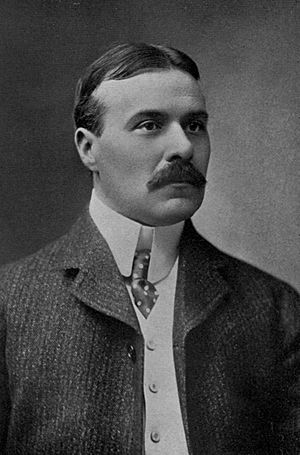Robert W. Chambers facts for kids
Quick facts for kids
Robert William Chambers
|
|
|---|---|
 |
|
| Born | May 26, 1865 Brooklyn, New York, U.S. |
| Died | December 16, 1933 (aged 68) New York City, U.S. |
| Occupation | Novel and short story author |
| Genre | Art Nouveau, decadent literature, fantasy, historical fiction, horror, romance, science fiction, supernatural |
| Notable works | The King in Yellow |
| Signature | |
Robert William Chambers (born May 26, 1865 – died December 16, 1933) was an American artist and writer. He is most famous for his book of short stories called The King in Yellow, which came out in 1895. This book is known for its spooky and strange tales.
Contents
Life of a Writer
Robert Chambers was born in Brooklyn, New York. His father, William P. Chambers, was a lawyer. His mother was Caroline Smith Boughton. Robert first went to the Brooklyn Polytechnic Institute. Later, he studied art at the Art Students League of New York when he was about 20. He even studied art in Paris, France, from 1886 to 1893. His artwork was shown in famous art shows there.
When he came back to New York, Robert sold his drawings to popular magazines like Life and Vogue. But then, he decided to focus on writing instead. His first novel was In the Quarter.
The King in Yellow
His most famous book, The King in Yellow, was published in 1895. It's a collection of short stories that are a bit strange and spooky. These stories are linked by a made-up play also called The King in Yellow. In the stories, anyone who reads this play goes crazy. This book was very important in American supernatural fiction. Famous horror writer H. P. Lovecraft really liked it.
Chambers wrote more weird stories later, but none were as popular as The King in Yellow. He also wrote some science fiction stories. These included In Search of the Unknown, which was about a zoologist who found strange creatures.
Other Kinds of Stories
Robert Chambers also wrote many historical fiction novels. These stories were set in different times, like the Franco-Prussian War and the American Civil War. He wrote Cardigan (1901), a historical novel for younger readers. It was set during the start of the American Revolution.
Later in his career, Chambers started writing romantic fiction to make a living. Many of his books sold very well. Some even became best-sellers. During World War I, he wrote adventure stories about the war.
Robert Chambers lived in Broadalbin, New York, during the summers. Some of his novels even talked about life in that area long ago.
In 1898, he married Elsa Vaughn Moller. They had one son, Robert Edward Stuart Chambers. Robert W. Chambers passed away on December 16, 1933.
His Impact and Legacy
Even though Robert Chambers stopped writing weird stories later on, his early works, especially The King in Yellow, stayed popular. This was partly because H. P. Lovecraft wrote about them in his study of horror literature.
Another writer, Frederic Taber Cooper, once said that Chambers's work could be frustrating. He felt that Chambers "might so easily have made it better."
Wendy Bousfield, who studied Chambers's historical novels, said that Cardigan was his most praised historical book. She also noted that while his historical details were good, some of his characters and humor were not.
Chambers's novel The Tracer of Lost Persons was turned into a popular radio show called Mr. Keen, Tracer of Lost Persons.
The King in Yellow has inspired many modern authors. Some of these include Stephen King and Nic Pizzolatto, who created the TV show True Detective.
Movies Based on His Work
Many of Robert Chambers's stories and novels have been made into movies. Most of these were silent films from the early 1900s. Here are a few examples:
- The Reckoning (1908), a short film.
- The Common Law (1916).
- Cardigan (1922), for which Chambers helped write the screenplay.
- America (1924), also with a screenplay by Chambers.
- Operator 13 (1934), a film based on his short stories.
- A Time Out of War (1954), a short film.
- The Yellow Sign (2001), a film based on one of his famous short stories.
See also
 In Spanish: Robert William Chambers para niños
In Spanish: Robert William Chambers para niños


